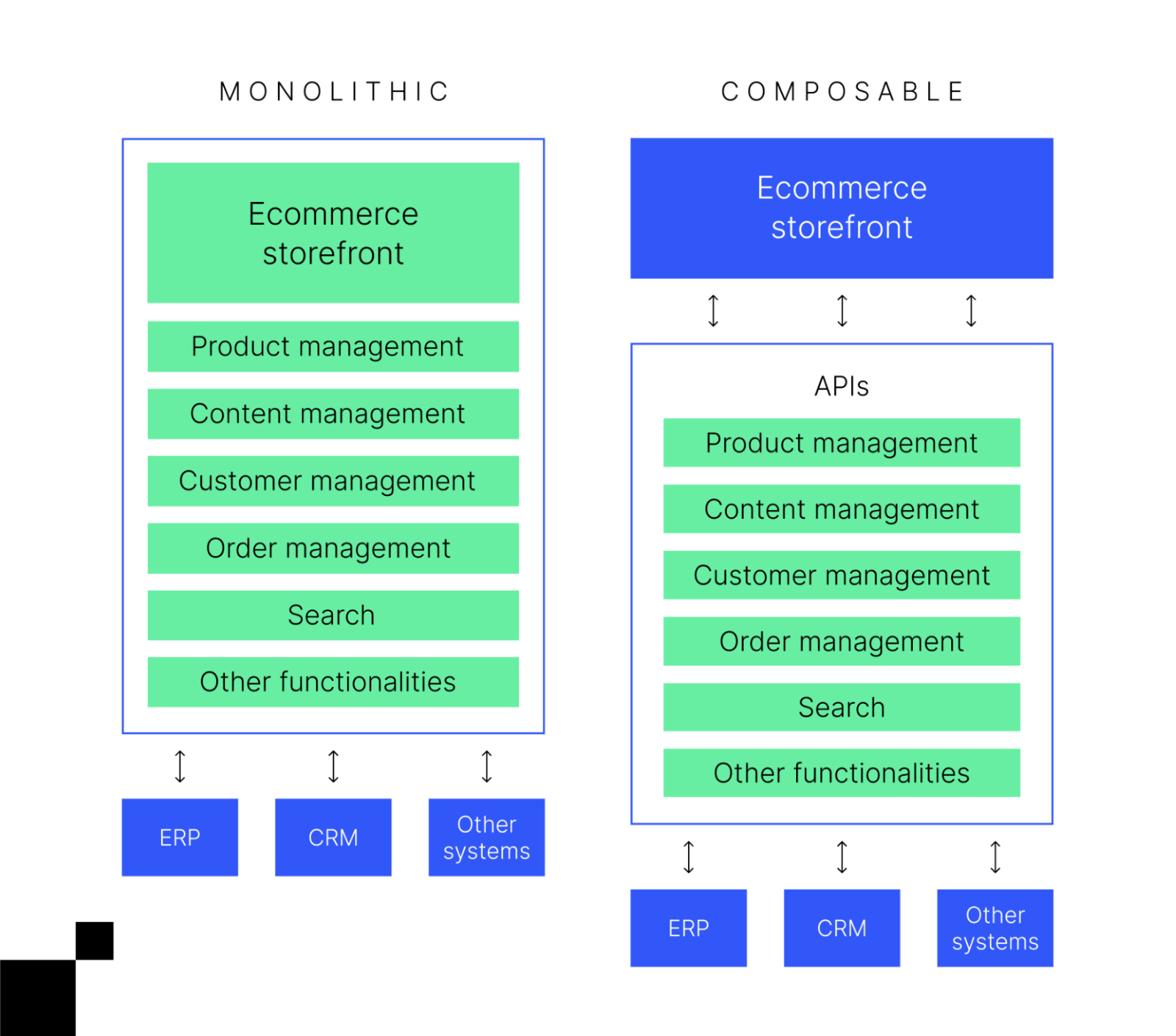Meeting customer expectations and delivering ever greater digital experiences has become pivotal for thriving businesses. However, achieving these goals often requires a different perspective on technology architecture. While single tech stacks have become an efficient way of managing the suite of tools needed to construct exceptional experiences, they can present issues in terms of flexibility and agility.
This is where a ‘composable architecture’ comes into its own. It enables businesses to simplify complexity by assembling independent and reusable components to create digital experiences. This means that teams can dedicate their time to what truly counts: the needs and satisfaction of customers.
The term ‘composable architecture’ was coined by Gartner in 2020, who predicted that by “2023, organisations that have adopted an intelligent composable approach will outpace competition by 80% in the speed of new feature implementation”.
Composable architecture is about breaking up your tech stack into smaller pieces that work together. This breaks down complex ecosystems into more manageable chunks for better oversight, flexibility, and adaptability. So, for example, content, search and payment functionalities - either purchased or custom-developed – are separate entities, managed independently, but all work together seamlessly. This is the opposite of what most technology has looked like so far, where everything is in one suite, with a big monolith taking care of everything.
Wordpress, Magento or AEM are all ‘monoliths’ where everything has to run through the solution. While Contentful is a CMS that only takes care of content, no front-end layer, no search functionality. For search you can think of Algolia and for payments, Adyen solutions. The difference is these are all API- based, so they live on their own but communicate with each other.

The composable approach really benefits experience. An ecommerce business might need to run multiple channels - website, app, marketplaces, voice - or may have multiple commercial models – one-time pay, subscriptions, marketplace splits - so fulfilling all of these can get troublesome with the plug and play features of a monolith ecommerce platform. Let’s face it, no platform offers it all. But with composable, you can pick the best-of-breed solution for each siloed feature.
So, for example, if you’re an ecommerce business, with a composable architecture you can have a headless CMS (contentful or contentstack), an ecommerce engine (commercetools or bigcommerce) and search (eg algolia) - all separate systems working together. And you can build on this. If your focus is on pricing and promotions, you can use a system such as talon.one or a personalisation service like ninetailed.
The advantages of adopting a composable architecture approach are numerous:
Select the best options with a modular approach
You can select the feature or functionality you need and add as a module into the ecosystem. The same goes for removing or replacing one. This gives you both flexibility and agility.
Best of breed means best experience
As you can focus on best-of-breed, you can select the technology that will enable you to deliver the best experience for your customers - no small trade-offs are required.
Tackling costs and big bang releases
Re-platforming can be a big and costly project, which entails ‘big releases’, ie you switch all or most features to the new platform in one go. A composable approach allows you to go step by step.
Omnichannel advantage
With composable, you can service all the channels you want – adding them or removing them. All with ease and with no impact on the other channels.
Future proofing
We know technologies are constantly changing. With a composable approach, you can add any new channel or feature as it becomes available. This future-proofs your setup.
Enhancing security
The adoption of composability not only enhances the usability and capabilities of your system but also contributes to its security. The independent operation of each technological component ensures that a failure or compromise in one element does not adversely impact others.
Vendor dependency
All-in-one systems are convenient, but you become totally dependent on this one vendor. If the vendor does not have a certain feature, you will need to customise - which can affect stability – or you might not even be able to implement the particular feature at all. With a composable approach, you can pick what you want and use just what you need.
Of course, there are great all-in-one systems on the market, they’re just not always a fit for everybody. Typically, it’s organisations with multiples locations, brands or commercial models that consider composable architecture. Luxid has built multiple commercial models for HMD with both a DTC model and a subscription model.
If you’re thinking of moving to composable architecture, there are some key things you need to focus on to get started.
Where are you now?
A good start point for considering a composable approach is to review where you are right now and the capabilities you have. Assess what’s possible and what isn’t, and review your tech stack – is it modern or approaching end of life? Considering composable as an approach could come from a very simple premise, eg your current systems do not work or are slowing you down or you want to explore new opportunities.
Importantly, you must assess whether your client and product data are in order. For example, if your current CRM and PIM data are distorted and of poor quality, going composable will simply lead to bad results. And you need to assess your current user experience. This can be in terms of process, self-help, customer service and marketing. Use of personas and customer journeys can help here.
Questions at the stage aren’t necessarily technically driven, but they do give insight into where technology may need support.
What do your future needs look like?
You may be focused on solving the problems of today, but assessing what the future looks like can really help you decide whether composable is right. Look internally at your business and also externally, eg what your customers may expect from you. Think outside the box and consider the likes of AR or VR – they might not be relevant now, but they could be in the future.
Evaluate your technology approach
As part of this, you will inevitably review costs, licenses, implementation and maintenance. But you should also assess how you would roll out composable – will you do it in one go, or opt for a phased approach with best-of-breed selection? Both have pros and cons. It can be better, for example, to go for a ‘big bang’ when your current technology stack is burning or is reaching end of life on support.
Assess the impact on the operating team
Going composable will require the understanding and participation of your operating team. And the richer you want to make your customer experiences, the more time that will need to be spent on operating them. Even though composability makes it easier to add a service to your tech stack in terms of implementation, from an operating point of view this still requires more people to run it. These will be a mix of tech savvy people creating flows in the system and marketing professionals assessing which content is served, where.
Composable architecture isn’t an approach for everyone. It tends to be more suitable for organisations with sufficient complexity and size to leverage its benefits. And it typically requires the organisation to stay abreast of tech advancements and to actively support the architecture.
But, when appropriate and implemented correctly, a composable approach is a powerful architecture for organisations seeking enhanced agility in order to navigate the dynamic demands of the market. If you’re looking to simplify your tech architecture to boost flexibility and agility and to free up your teams to focus on the needs of customers, then talk to an expert at Luxid’s Digital Experience solution to see if composable is right for your business.










